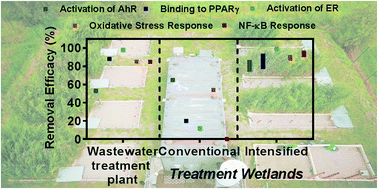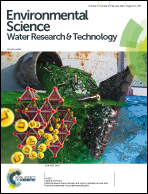Application of cell-based bioassays to evaluate treatment efficacy of conventional and intensified treatment wetlands†
Abstract
Constructed wetlands are commonly used for wastewater treatment when centralized sewage treatment is not feasible. Many studies have focused on the removal of micropollutants by treatment wetlands, but little is known about how well they can remove biological activity. Here we studied the removal efficacy of conventional and intensified treatment wetland designs using both chemical analysis of conventional wastewater parameters and treatment indicator chemicals (caffeine, ibuprofen, naproxen, benzotriazole, diclofenac, acesulfame, carbamazepine) as well as a panel of in vitro bioassays indicative of different stages of cellular toxicity pathways, such as xenobiotic metabolism, receptor-mediated effect and adaptive stress responses. Water samples collected before and after seven treatment wetlands were compared against the adjacent municipal wastewater treatment plant. The intensified treatment wetlands generally removed micropollutants and biological activity to a greater extent than the conventional wastewater treatment plant, whereas the conventional horizontal subsurface flow wetland showed poor removal of all indicators. Carbamazepine was not well removed by any of the studied systems as expected from reported recalcitrance in aerobic environments. Estrogenic activity, which is a commonly used biological endpoint indicator for wastewater treatment, was removed very well by the intensified wetlands (97 to 99.5%) with similar or slightly lower removal efficacy for all other biological endpoints. The results highlight the importance of applying indicator bioassays complementary to indicator chemical analysis for monitoring treatment efficacy. The high removal efficacy of biological effects as a measure of total effect-scaled concentrations of chemicals provides further support to the use of intensified wetlands for wastewater treatment.

- This article is part of the themed collection: Research from our newest ESPI Editorial Board members


 Please wait while we load your content...
Please wait while we load your content...